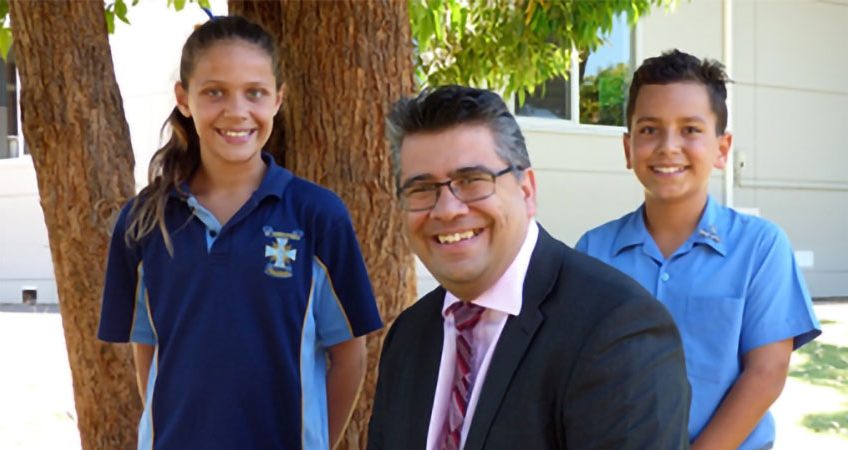Mass For The Feast Of St Mary Of The Cross Mackillop

HOMILY FOR MASS FOR THE FEAST OF ST MARY OF THE CROSS MACKILLOP + PARISH VISITATION
St. Christopher’s Church, Panania

When Mary MacKillop was about 20 years old, living in Portland, Victoria, she was accidentally locked in the church overnight. You might think that was a rather spooky thing to happen to someone, but Mary counted it as an unexpected but graced opportunity to spend an all-night Vigil with Our Lord’1. It proved to be a turning point in her life. Her great mission of serving God’s young and poor, especially through education, began, as all true missions do, in prayer and contemplation. We can be distracted by Mary’s extraordinary activity and achievements – already by the time she died, there were 650 ‘Joeys’, or Sisters of St. Joseph, educating 12,000 children! We can forget that she was, before all else, a great woman of prayer. In fact, her sisters Annie and Lexie would tease Mary at the first Josephite ‘convent’, Winella Cottage, for engaging in such lengthy periods of prayer”2. Perhaps they thought she was just malingering; perhaps they thought she was playing the saint; little did they know! But it was in prayer that Mary heard God’s call to educate young Australians and to do so through her own version of religious life.
It all began when Alex MacKillop, an ex-seminarian, emigrated to Australia and met and married another Scots émigré, Flora. He was a strong influence on their seven children, especially the eldest, Mary Helen. But Alex never really settled down: he was at sea or on the road for much of his life. And he was clueless with money, so his family were poor. Mary inherited the first tendency (to be a gadabout) but reacted against the second (to be a poor administrator).
She left home aged 14 to help support her family as a shop assistant and child-carer. Then came her fateful meeting with Fr Julian Tennyson Woods in Penola: together they opened the first free Catholic school and began the Sisters of Saint Joseph. By 1869 she was ready to take her final vows. The next few years were difficult, due to financial struggles and the absence of supportive bishops at the (First) Vatican Council. But her upbringing in adverse circumstances had made her hardy, like her iconographical emblem the eucalyptus tree. It also made her sympathetic to the needs of bush children, for whom she devised her system of education based on the four Rs of reading, writing, ’rithmetic and religion.
In our second reading today St Paul offers us something of a blueprint for any Christian community, including the parish and the school of St. Christopher’s. A Catholic school must be a place where young people are given a good education and an education in goodness, which means every opportunity to develop their gifts – to learn head knowledge and skills, but also to cultivate heart knowledge or character. St Paul says we must “clothe ourselves with compassion, kindness, humility, meekness and patience,” cultivate forbearance, forgiveness, gratefulness, above all love, “which binds everything together in perfect harmony” (Col 3:12-17).
 None of which, you might say, is a monopoly of the Catholic school or even the Christian community. But next St Paul adds to his list of what we must learn: “And let the Peace of Christ reign in your hearts… Let the Word of Christ dwell richly in your minds”. And how is that to happen? “Teach and advise each another in all Wisdom,” Paul goes on. “With gratitude in your hearts, sing psalms and hymns and sacred songs to God. And whatever you do, in word or deed, do in the name of the Lord Jesus”. The Catholic school is a great school, but it is first and foremost a place to meet Jesus and grow in His friendship; a place where young people learn to live and love as parts of one body; a place where the peace of Christ fills their hearts and the wisdom of Christ their minds. And whatever else we learn or do, we must put on “the overalls of love”, Paul says, which means putting on Christ’s love for us and within us and working through us.
None of which, you might say, is a monopoly of the Catholic school or even the Christian community. But next St Paul adds to his list of what we must learn: “And let the Peace of Christ reign in your hearts… Let the Word of Christ dwell richly in your minds”. And how is that to happen? “Teach and advise each another in all Wisdom,” Paul goes on. “With gratitude in your hearts, sing psalms and hymns and sacred songs to God. And whatever you do, in word or deed, do in the name of the Lord Jesus”. The Catholic school is a great school, but it is first and foremost a place to meet Jesus and grow in His friendship; a place where young people learn to live and love as parts of one body; a place where the peace of Christ fills their hearts and the wisdom of Christ their minds. And whatever else we learn or do, we must put on “the overalls of love”, Paul says, which means putting on Christ’s love for us and within us and working through us.
My young friends, in your school years you will have daily opportunities to get to know Jesus better, to know yourselves better, and to know your world better – through prayer and sacrament, through the example of your teachers and fellow students, from your religious education classes and other studies, from the pastoral care you receive and other aspects of your school’s life. Our Church and society need young people like yourselves to be as well-formed and well-informed as you can be, with big hearts and creative minds, with compassion and courage.
Inscribed on Mary Mackillop’s tomb in North Sydney is the motto, ‘Remember we are but travellers here.’ Like her Dad she proved to be a prolific traveller, criss-crossing the country and the globe, visiting her houses, Aboriginal missions, Church leaders and benefactors. What a sight she must have been galloping into town, on horseback in her full brown habit! But it’s not this sort of travelling that Mary meant when she said we are travellers. It’s the sort of travelling Jesus hints at when He talks about ‘setting our sights on the kingdom of heaven’. He’s reminding us that in this world we are only on the road; heaven is our destination, and so, like Mary Mackillop, we ‘strive to please God, rather than men, always ready to abandon everything for Christ.’’3 Children of St Christopher’s – and adults too – join her now on the road to heaven, for we are but travellers here. Be the next crop of saints for Australia!
INTRODUCTION TO MASS FOR THE FEAST OF ST MARY OF THE CROSS MACKILLOP + PARISH VISITATION
St. Christopher’s Church, Panania
Welcome to this celebration of the Eucharist as I begin my canonical visitation of the Parishes of Panania and Revesby Heights. I’m looking forward to my several Masses and visiting the parishes and schools, meeting with the Parish Pastoral Teams, various group leaders and individual parishioners, with leaders, staff and students of St Christopher’s Primary and De La Salle College, with young adults, local clergy, and with the elderly and infirm in their homes or nursing homes. I thank Fr Maurice and all the parishioners in advance. And to everyone present this morning a very warm welcome!
Today is of course the Feast Day of the Co-Patron of our country, St Mary of the Cross MacKillop. Conscious of the call to us all to be saint for our times, we repent of our sins…
1. Paul Gardiner SJ, An Extraordinary Australian: Mary MacKillop (2011) p47
2. Gardiner, p. 57
3. Second Vatican Council, Apostolicam actuositatem, 4

